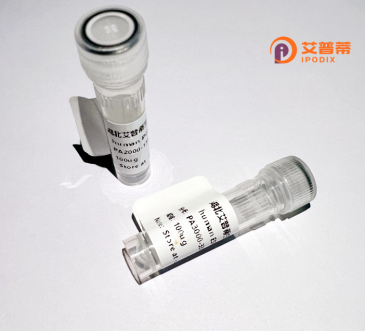
| 纯度 | >90%SDS-PAGE. |
| 种属 | Human |
| 靶点 | KCNQ4 |
| Uniprot No | P56696 |
| 内毒素 | < 0.01EU/μg |
| 表达宿主 | E.coli |
| 表达区间 | 1-695aa |
| 活性数据 | MAEAPPRRLGLGPPPGDAPRAELVALTAVQSEQGEAGGGGSPRRLGLLGSPLPPGAPLPGPGSGSGSACGQRSSAAHKRYRRLQNWVYNVLERPRGWAFVYHVFIFLLVFSCLVLSVLSTIQEHQELANECLLILEFVMIVVFGLEYIVRVWSAGCCCRYRGWQGRFRFARKPFCVIDFIVFVASVAVIAAGTQGNIFATSALRSMRFLQILRMVRMDRRGGTWKLLGSVVYAHSKELITAWYIGFLVLIFASFLVYLAEKDANSDFSSYADSLWWGTITLTTIGYGDKTPHTWLGRVLAAGFALLGISFFALPAGILGSGFALKVQEQHRQKHFEKRRMPAANLIQAAWRLYSTDMSRAYLTATWYYYDSILPSFRELALLFEHVQRARNGGLRPLEVRRAPVPDGAPSRYPPVATCHRPGSTSFCPGESSRMGIKDRIRMGSSQRRTGPSKQHLAPPTMPTSPSSEQVGEATSPTKVQKSWSFNDRTRFRASLRLKPRTSAEDAPSEEVAEEKSYQCELTVDDIMPAVKTVIRSIRILKFLVAKRKFKETLRPYDVKDVIEQYSAGHLDMLGRIKSLQTRVDQIVGRGPGDRKAREKGDKGPSDAEVVDEISMMGRVVKVEKQVQSIEHKLDLLLGFYSRCLRSGTSASLGAVQVPLFDPDITSDYHSPVDHEDISVSAQTLSISRSVSTNMD |
| 分子量 | 77.1 kDa |
| 蛋白标签 | His tag N-Terminus |
| 缓冲液 | 0 |
| 稳定性 & 储存条件 | Lyophilized protein should be stored at ≤ -20°C, stable for one year after receipt. Reconstituted protein solution can be stored at 2-8°C for 2-7 days. Aliquots of reconstituted samples are stable at ≤ -20°C for 3 months. |
| 复溶 | Always centrifuge tubes before opening.Do not mix by vortex or pipetting. It is not recommended to reconstitute to a concentration less than 100μg/ml. Dissolve the lyophilized protein in distilled water. Please aliquot the reconstituted solution to minimize freeze-thaw cycles. |
以下是关于重组人KCNQ4蛋白的参考文献(简化为标题、作者及摘要核心内容):
1. **"Molecular Structure and Function of the KCNQ4 Potassium Channel: A Key Mediator of Auditory Signaling"**
*作者:Kubisch C. et al.*
**摘要**:克隆并鉴定了人类KCNQ4的基因结构,发现其突变导致遗传性耳聋。通过重组KCNQ4蛋白在HEK293细胞中的表达,证实其在钾离子通道中的作用,并揭示其在耳蜗毛细胞中的特异性分布。
2. **"Regulation of Recombinant KCNQ4 Channels by Calcium/Calmodulin"**
*作者:Gamper N., Shapiro M.S.*
**摘要**:研究钙调蛋白对重组KCNQ4通道的调控作用,发现细胞内钙离子通过钙调蛋白结合调控KCNQ4的活性,影响神经元兴奋性和听觉信号传导。
3. **"Pharmacological Activation of KCNQ4 Channels as a Potential Therapeutic Strategy for Hearing Loss"**
*作者:Schmitt N. et al.*
**摘要**:利用重组KCNQ4蛋白筛选小分子化合物,发现特定药物可通过增强通道开放改善钾电流,提出其在治疗耳聋中的潜力。
4. **"Electrophysiological Characterization of Recombinant Human KCNQ4 in Mammalian Cells"**
*作者:Jespersen T. et al.*
**摘要**:通过电生理记录和突变分析,系统研究重组KCNQ4的电压依赖性及药理学特性,揭示其与家族性耳聋相关突变的致病机制。
如需获取全文,建议通过PubMed或相关期刊数据库检索具体标题及作者。
Recombinant human KCNQ4 protein is a genetically engineered form of the potassium voltage-gated channel subfamily Q member 4. a critical component of voltage-gated potassium (Kv) channels. Encoded by the KCNQ4 gene, this protein assembles into tetrameric channels that mediate M-type (muscarinic-sensitive) potassium currents, regulating neuronal excitability and resting membrane potential. KCNQ4 is predominantly expressed in the auditory system, particularly in outer hair cells of the inner ear, where it maintains potassium homeostasis essential for hearing. Mutations in KCNQ4 are linked to autosomal dominant nonsyndromic hearing loss (DFNA2), characterized by progressive high-frequency hearing impairment due to hair cell degeneration.
Recombinant KCNQ4 allows researchers to study channel physiology, mutational effects, and pharmacological modulation in vitro. Produced using heterologous expression systems (e.g., HEK293 cells), it retains functional properties like voltage-dependent activation, sensitivity to Kv7 channel blockers (e.g., XE991), and opener compounds (e.g., retigabine). Its structure-function relationships, including interactions with auxiliary subunits (e.g., KCNE proteins) or calmodulin, are key research focuses. Additionally, recombinant KCNQ4 aids in drug discovery for hearing disorders or neurological conditions involving Kv7 channel dysfunction. Studies using this protein have advanced understanding of K+ channelopathies and therapeutic strategies to enhance channel activity or rescue pathogenic variants.
×